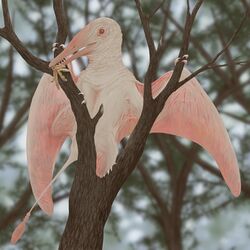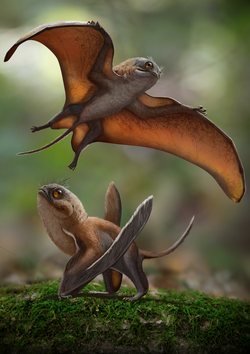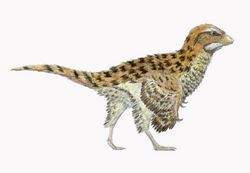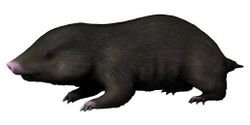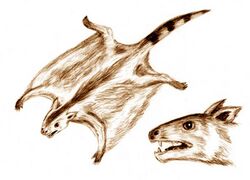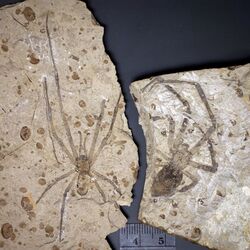Earth:Tiaojishan Formation
| Tiaojishan Formation Stratigraphic range: Bathonian-Oxfordian ~165–153 Ma | |
|---|---|
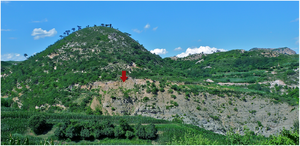 Exposure of the Tiaojishan Formation at Nanshimenzi Village, Qinglong Manchu Autonomous County, Hebei Province, with red arrow pointing to fossiliferous beds | |
| Type | Geological formation |
| Underlies | Tuchengzi Formation, Houcheng Formation |
| Overlies | Haifanggou Formation |
| Thickness | 2,420 m (7,940 ft) |
| Lithology | |
| Primary | Andesite |
| Other | Sandstone, shale, tuff, coal |
| Location | |
| Coordinates | [ ⚑ ] : 41°18′N 119°12′E / 41.3°N 119.2°E |
| Paleocoordinates | [ ⚑ ] 43°00′N 123°06′E / 43.0°N 123.1°E |
| Region | Hebei, Inner Mongolia, & Liaoning |
| Country | |
| Extent | Yanshan Belt |
| Lua error in Module:Location_map/multi at line 27: Unable to find the specified location map definition: "Module:Location map/data/Liaoning" does not exist. | |
The Tiaojishan Formation is a geological formation in Hebei and Liaoning, People's Republic of China, dating to the middle-late Jurassic period (Bathonian-Oxfordian stages). It is known for its exceptionally preserved fossils, including those of plants, insects and vertebrates. It is made up mainly of pyroclastic rock interspersed with basic volcanic and sedimentary rocks. Previously, the Tiaojishan Formation was grouped together with the underlying Haifanggou Formation (also known as the Jiulongshan Formation) as a single "Lanqi Formation."[1] The Tiaojishan Formation forms a key part of the Yanliao Biota assemblage, alongside the Haifanggou Formation.
Age
Using Argon–argon dating, Wang and colleagues in 2005 dated part of the Tiaojishan Formation to about 160 million years ago, the beginning of the Oxfordian stage, the first stage of the Upper Jurassic epoch.[2] In 2006, a study by Liu and colleagues used U-Pb zircon dating to conclude that the Tiaojishan Formation correlates with the Daohugou Beds, and the complete chronological range of this shared biota dates to between 168 and 164/152 Ma ago.[3] A subsequent study, published in 2008, refined the age range of the formation further, finding that the lower boundary of the Tiaojishan was formed 165 Ma ago, and the upper boundary somewhere between 156 and 153 Ma ago.[4]
Climate
Based on the plant life present in the Tiaojishan Formation, Wang Yongdong and colleagues determined that the climate in Liaoning during the mid Jurassic would have been subtropical to temperate, warm and humid.[1]
Fauna
Beautifully preserved fossils of dinosaurs, pterosaurs, salamanders, insects, arachnids[5] and other invertebrates, conifers, ginkgoes, cycads, horsetails, and ferns, and even the earliest known gliding mammal (Volaticotherium) have been discovered in these rocks.The tuffaceous composition of some rock layers show that this was a volcanic area, occasionally experiencing heavy ashfalls from eruptions. The landscape then was dominated by mountain streams and deep lakes surrounded by forests of gymnosperm trees.[6]
The forests of the Yanliao biota grew in a humid, warm - temperate climate and were dominated by gymnosperm trees. There were ginkgopsids like Ginkoites, Ginkgo, Baiera, Czekanowskia, and Phoenicopsis. There were also conifers like Pityophyllum, Rhipidiocladus, Elatocladus, Schizolepis, and Podozamites. Also, Lycopsids like Lycopodites and Sellaginellities, horsetails (Sphenopsida) like Equisetum, cycads like Anomozamites, and ferns (Filicopsida) like Todites and Coniopteris.[7]
Salamanders
| Salamanders of the Tiaojishan Formation | ||||||
|---|---|---|---|---|---|---|
| Genus | Species | Location | Stratigraphic position | Abundance | Notes | Images |
|
Beiyanerpeton |
B. jianpingensis[8] |
Liaoning |
A salamandroid known from an almost complete and articulated skeleton exposed in ventral view. |
|||
|
C. tianyiensis |
A cryptobranchoid measuring 18 centimeters in length. | |||||
|
J. paradoxus |
A cryptobranchoid with a strange skull morphology, at first believed to come from the Early Cretaceous. | |||||
|
L. daohugouensis |
A little-known cryptobranchoid. | |||||
|
P. sinensis |
A cryptobranchoid characterized by its short trunk (only 14 presacrals) and short and wide head, giving a fat body shape, from which the genus name was derived ("Pang" means fat in Chinese). | |||||
Pterosaurs
| Pterosaurs of the Tiaojishan Formation | ||||||
|---|---|---|---|---|---|---|
| Genus | Species | Location | Stratigraphic position | Abundance | Notes | Images |
|
Archaeoistiodactylus |
A. linglongtaensis[9] |
Liaoning |
A monofenestratan known from an incomplete skeleton with a partial skull and lower jaw. |
|||
|
Cascocauda |
C. rong[10] |
Hebei |
Daohugou bed[11] |
One specimen |
A long-tailed batrachognathine anurognathid known from a complete skeleton of a juvenile with extensive preservation of pycnofibres and wing membranes. | |
|
Changchengopterus |
C. pani[12] |
Hebei |
A pterodactyliform known only from a single specimen of a young juvenile, measuring 475 millimeters (18.7 in) in wingspan. | |||
|
Daohugoupterus |
D. delicatus[13] |
One specimen |
A relatively basal pterosaur known from a partial skeleton with soft tissue impressions. | |||
|
D. modularis[14] |
Liaoning |
A wukongopterid named after Charles Darwin. The type species, D. modularis was the first known pterosaur to display features of both long-tailed rhamphorhynchoids and short-tailed pterodactyloids, and was described as a transitional fossil between the two groups. Darwinopterus specimens have also been reported to show several differences between males and females, with the males having distinctive crests on their heads. They are known to have laid their eggs on the ground, and may have also not shown that much for parental care. | ||||
|
D. linglongtaensis |
||||||
|
D. robustodens |
||||||
|
D. curvidentatus? |
One specimen |
An anurognathid pterosaur of uncertain age. Originally reported from the Cretaceous aged Yixian Formation, it may be instead be from the mid-Jurassic Daohugou beds.[15] | ||||
|
Douzhanopterus |
D. zhengi[16] |
Linglongta |
One specimen |
A non-pterodactyloid monofenestratan with a proportionately short tail. | ||
|
Fenghuangopterus |
F. lii[17] |
Liaoning |
A scaphognathine rhamphorhynchid similar to other scaphognathines in its short, blunt skull with a large antorbital fenestra, and widely spaced, vertically oriented teeth (as opposed to the horizontally-oriented teeth of other rhamphorhynchids). | |||
|
Jeholopterus |
J. ninchengensis |
Inner Mongolia |
A batrachognathine anurognathid preserved with pycnofibres and skin remains. | |||
|
Jianchangnathus |
J. robustus[20] |
Liaoning |
A scaphognathine rhamphorhynchid known from a single fossil skeleton. | |||
|
Jianchangopterus |
J. zhaoianus[21] |
Liaoning |
A scaphognathine rhamphorhynchid known from a nearly complete skeleton with the skull preserved. | |||
|
Kunpengopterus |
K. sinensis[22] |
Liaoning |
Daohugou bed |
Three specimens |
A wukongopterid with an elongated head, 106.9 millimeters long, and an opposed thumb. | |
|
K. antipollicatus[23] |
Liaoning |
Two nearly complete specimens | ||||
|
Liaodactylus |
L. primus[24] |
Daxishan (Linglongta) |
One specimen |
A ctenochasmatid pterosaur with elongated, comb-like teeth. | ||
|
Hebei |
One specimen |
A batrachognathine anurognathid, originally thought to be from the Early Cretaceous, with a wingspan that is about 40 centimeters, making it one of the smallest known pterosaurs. Originally classed as a species of Dendrorhynchoides. | ||||
|
Pterorhynchus |
P. wellnhoferi |
Inner Mongolia |
Daohugou bed |
One specimen[18] |
A darwinopteran with a tall crest on its head and an elongated skull 11.8 centimeters (4.6 in) long, a long tail and a wingspan of about 85 centimeters (33 in). It was originally believed to be a rhamphorhynchid. The only known specimen consists of an articulated, nearly complete skeleton with remains of the integument. These included the wing membrane, hair-like pycnofibers, a long version of the vane found at the end of "rhamphorhynchoid" tails, and a head crest with both a low bony base and a large keratin extension. | |
|
Qinglongopterus |
Q. guoi[26] |
Liaoning |
A rhamphorhynchine rhamphorhynchid known from only one specimen that includes a skeleton with a skull. | |||
|
Sinomacrops |
S. bondei[11] |
Hebei |
Daohugou bed |
One specimen |
A long-tailed batrachognathine anurognathid known from a relatively complete skull and skeleton with soft tissue patches. | |
|
Wukongopterus |
W. lii |
Liaoning |
Daohugou bed |
One specimen[27] |
A wukongopterid unusual for having both an elongate neck and a long tail. Its wingspan is estimated at 730 millimeters (29 in). | |
Dinosaurs
| Dinosaurs of the Tiaojishan Formation | ||||||
|---|---|---|---|---|---|---|
| Genus | Species | Location | Stratigraphic position | Abundance | Notes | Images |
|
A. huxleyi[28] |
Liaoning |
Several specimens[29] |
An anchiornithid at first believed to be a troodont. Given the exquisite preservation of one of the first specimen's fossils, Anchiornis became the first dinosaur species for which almost the entire life coloration could be determined. Most of the body feathers of Anchiornis were gray and black. The crown of head feathers was mainly rufous with a gray base and front, and the face had rufous speckles among predominantly black head feathers. The wing and hind leg feathers were white with black tips. The coverts were gray, contrasting the mainly white main wings. The larger coverts of the wing were also white with gray or black tips, forming rows of darker dots along mid-wing. These took the form of dark stripes or even rows of dots on the outer wing (primary feather coverts) but a more uneven array of speckles on the inner wing (secondary coverts). The shanks of the legs were gray other than the long leg feathers, and the feet and toes were black. It was 13 inches long and weighed only 110 grams (3.9 ounces). |
|||
|
A. xui |
Liaoning |
One specimen |
An anchiornithid roughly the size of a modern pheasant, with a length of 20 inches. Its leg bones were similar to those of Archaeopteryx, but overall its anatomy was more primitive. | |||
|
C. juji |
Hebei |
Yanliao Biota |
One specimen |
An anchiornithid known from an adult specimen measuring 400 mm in body length. Its fossilized feathers possess nanostructures which were analyzed and interpreted as melanosomes, showing similarity to organelles that produce a black iridescent color in certain species of extant birds. Other feathers found on the head, chest, and the base of the tail preserve flattened sheets of platelet-like melanosomes very similar in shape to those which create brightly colored iridescent hues in the feathers of modern hummingbirds. However, these structures are seemingly solid and lack air bubbles, and thus are internally more akin to the melanosomes in trumpeters than hummingbirds. Caihong represents the oldest known evidence of platelet-like melanosomes. It is named for the large crest on the lacrimal bone of the skull.[30] | ||
|
E. brevipenna |
Liaoning |
One specimen |
An anchiornithid at first believed to be a troodont, known from a single fossil specimen representing the nearly complete skeleton of a subadult or adult individual. The specimen is very small, measuring about 12 inches long. | |||
|
Epidexipteryx |
E. hui |
Daohugou beds |
One specimen |
A scansoriopterygid known from a well-preserved partial skeleton, measuring 10 inches in length (17.5 inches including the incomplete tail feathers), that includes four long feathers on the tail, composed of a central rachis and vanes. However, unlike in modern-style rectrices, the vanes were not branched into individual filaments but made up of a single ribbon-like sheet. Epidexipteryx also preserved a covering of simpler body feathers, composed of parallel barbs as in more primitive feathered dinosaurs. However, the body feathers of Epidexipteryx are unique in that some appear to arise from a "membranous structure" at the base of each feather. It has been suggested that this may represent a stage in the evolution of the feather. Epidexipteryx and its kin represent the earliest known examples of ornamental feathers in the fossil record. | ||
|
Pedopenna |
P. daohugouensis |
Inner Mongolia |
Daohugou beds |
One specimen |
An anchiornithid that probably measured 1 meter (3.3 feet) or less in length, but since this species is only known from the hind legs, the actual length is difficult to estimate. Apart from having a very birdlike skeletal structure in its legs, Pedopenna was remarkable due to the presence of long pennaceous feathers on the metatarsus (foot). Some other paravians are also known to have these 'hind wings', but those of Pedopenna differ from those of animals like Microraptor. Pedopenna hind wings were smaller and more rounded in shape. The longest feathers were slightly shorter than the metatarsus, at about 55 mm (2.2 in) long. Additionally, the feathers of Pedopenna were symmetrical, unlike the asymmetrical feathers of some other non-avian paravians and birds. Since asymmetrical feathers are typical of animals adapted to flying, it is likely that Pedopenna represents an early stage in the development of these structures. While many of the feather impressions in the fossil are weak, it is clear that each possessed a rachis and barbs, and while the exact number of foot feathers is uncertain, they are more numerous than in the hind-wings of Microraptor. Pedopenna also shows evidence of shorter feathers overlying the long foot feathers, evidence for the presence of coverts as seen in modern birds. Since the feathers show fewer aerodynamic adaptations than the similar hind wings of Microraptor, and appear to be less stiff, suggests that if they did have some kind of aerodynamic function, it was much weaker than in other non-avian paravians and birds. | |
|
Scansoriopteryx |
S. heilmanni |
Liaoning |
Exact provenance of type specimen unknown, most likely from the Daohugou Beds[31] |
One or two specimens |
A sparrow-sized scansoriopterygid known from one or two juvenile specimens. | |
|
S. sungei |
Liaoning |
One specimen[32] |
An anchiornithid with plumulaceous-like feathers. Feather imprints include wispy bundles along the neck, short and symmetrical vaned feathers on the arms, and both fuzz and long pennaceous feathers on its hind limbs (bearing a striking resemblance of the delicate hind limb filaments to the modern Silkie breed of domestic chicken). While its anatomy and integument share features with birds as well as derived dromaeosaurs such as Microraptor, cladistic analysis places the genus within the cluster of feathered non-avian dinosaurs near the origin of avialans. It was unlikely to be a flier. | |||
|
T. confuciusi |
Liaoning |
A heterodontosaur that was initially reported as being from the Early Cretaceous Jehol group. The fossil was collected at a locality transliterated as Linglengta or Linglongta. Lu et al., 2010, reported that these beds were actually part of the Tiaojishan Formation, dating from the Late Jurassic period. Tianyulong has a row of long, filamentous integumentary structures on the back, tail and neck of the specimen, similar to the feathers found in certain theropods (this suggests that all heterodontosaurs may have had these filaments). The holotype is from a subadult individual that probably measured 70 centimeters in length based on the proportions of the related Southern African species Heterodontosaurus. | ||||
|
X. zhengi[33] |
Liaoning |
One specimen |
An anchiornithid originally thought to be either a dromaeosaur or a troodont. It was morphologically similar to Archaeopteryx and was the size of a domestic chicken hen. It was about 60 cm long and weighed an estimated 0.82 kg. Like Archaeopteryx it had long forelimbs. Its femur was longer than its humerus, 84 mm as against 71 mm. | |||
|
Yi |
Y. qi[34] |
Hebei |
Daohugou beds |
One specimen |
A gliding scansoriopterygid, weighing about 380 grams (0.84 pounds), that, like other scansoriopterygids, possessed an unusual, elongated third finger, that (in the case of Yi) helped to support a membranous gliding plane made of skin. The planes of Yi were also supported by a long, bony strut attached to the wrist. This modified wrist bone and membrane-based plane is unique among all known dinosaurs, and might have resulted in wings similar in appearance to those of bats. This also leads to the hypothesis that the other two genera of scansoriopterygids also had gliding membranes, but this is yet to be proven official. | |
Lizards
| Lepidosaurs (lizards and relatives) of the Daohugou Beds | |||||
|---|---|---|---|---|---|
| Genus | Species | State | Abundance | Notes | Images |
|
Unnamed lizard[35] |
Inner Mongolia |
One specimen |
A new lizard with relatively short forelimbs |
||
|
Unnamed lizard[35] |
Inner Mongolia |
One specimen |
A lizard with long hind limbs and a narrow body |
||
Cynodonts
| Cynodonts of the Tiaojishan Formation | ||||||
|---|---|---|---|---|---|---|
| Genus | Species | Location | Stratigraphic position | Abundance | Notes | Images |
|
A. scansorius |
Daohugou bed |
A shrew-sized, arboreal docodontid that is known to be one of the earliest tree-climbing mammaliaforms.[36] It measured approximately 13 centimeters from head to tail and weighed about 27 grams. Its appearance was similar to a squirrel, with a long snout, curved, horny claws and flexible ankle and wrist joints typical of modern arboreal mammals. The front teeth were spade-like, indicating that Agilodocodon could gnaw tree bark and consume gum or sap. |
||||
|
A. jenkinsi |
Liaoning |
One specimen |
An arboreal, prehensile-tailed euharamiyid haramiyidan that was the largest known haramiyidan, estimated to have weighed about 354 grams.[37] Arboroharamiya is unlike any modern mammal in having a lower jaw that can move up, down, and backward, but not forward. It has a rodent-like dentition with enlarged incisors and molars and no canines. | |||
|
D. brachydactylus |
Hebei |
One specimen[38] |
A docodontid specialized for a subterranean burrowing lifestyle. The skeletal structure and body proportions are strikingly similar to the golden mole. It was at least 9 centimeters long, exempting the tail, and weighed at least 9 grams, or perhaps 16 grams. | |||
|
J. sinensis[39] |
Liaoning |
One specimen |
A small, shrew-like very basal eutherian with a body length approximately 70-100 millimeters. The discovery of Juramaia provides new insight into the evolution of placental mammals by showing that their lineage diverged from that of the metatheres 35 million years earlier than previously thought. Furthermore, its discovery fills gaps in the fossil record and helps to calibrate modern, DNA-based methods of dating the evolution. Based on climbing adaptations found in the forelimb bones, it has been suggested that the basal stock of eutherians was arboreal. | |||
| Maiopatagium | M. furculiferum | A gliding euharamiyidan similar in lifestyle to a colugo. | ||||
|
M. mammaliaformis |
Inner Mongolia |
Daohugou bed |
One specimen |
An eleutherodontid haramiyidan thought to have been a herbivore that lived on the ground, having a similar posture to modern-day armadillos and rock hyraxes.[40] Megaconus is estimated to have weighed about 250 grams (8.8 ounces). | ||
| Microdocodon | M. gracilis | Daohugou bed | A tegotheriid docodontan known from a specimen with a preserved hyoid bone, which is almost unknown in the early mammal fossil record. | |||
| Qishou | Q. jizantang | Euharamiyida | ||||
|
R. eurasiaticus |
Liaoning |
Daxishan site |
One specimen |
An omnivorous paulchoffatoid multituberculate that is the oldest so far described in the multituberculates. It strongly resembled a small rodent (like a rat or a chipmunk).[41] It is estimated to have weighed between 65 and 80 grams, about that of an average chipmunk. | ||
|
V. antiquum |
Inner Mongolia |
Daohugou bed |
One specimen |
A gliding, flying squirrel-like volaticotherian eutriconodont with a specialized gliding membrane. The teeth of Volaticotherium were highly specialized for eating insects, and its limbs were adapted to living in trees. The gliding membrane was insulated by a thick covering of fur, and was supported by the limbs as well as the tail. The discovery of Volaticotherium provided the earliest-known record of a gliding mammal, and provided further evidence of mammalian diversity during the Mesozoic Era. | ||
| Vilevolodon | V. diplomylos | A gliding eleutherodontid haramiyidan with a herbivorous diet. | ||||
| Xianshou | X. linglong, X. songae | A gliding euharamiyidan | ||||
Arthropods
The following orders are represented in the formation; Ephemeroptera, Odonata, Plecoptera, Blattodea, Orthoptera, Hemiptera, Neuroptera, Coleoptera, Hymenoptera, and Diptera.
An indeterminate aeshnoid (insect) species is known from Liaoning.[28]
| Arthropods of the Daohugou Beds | ||||||
|---|---|---|---|---|---|---|
| Genus | Species | State | Abundance | Notes | Images | |
|
Ahirmoneura |
A. neimengguensis[42] |
|||||
|
Archirhagio |
A. striatus[43] |
Archisargid flies | ||||
|
A. zhangi[44] |
Inner Mongolia |
|||||
|
Archisargus |
A. spurivenius[43] |
Archisargid flies | ||||
|
A. strigatus[43] |
||||||
|
Calosargus |
C. (Calosargus) antiquus[43] |
Archisargid flies | ||||
|
C. (C.) bellus[43] |
||||||
|
C. (C.) daohugouensis[43] |
||||||
|
C. (C.) hani[43] |
||||||
|
C. (C.) tenuicellulatus[43] |
||||||
|
C. (C.) validus[43] |
||||||
|
C. (Pterosargus) sinicus[43] |
Inner Mongolia |
|||||
|
D. impudica[28] |
Liaoning |
An ostracod |
||||
|
D. magna[28] |
Liaoning |
An ostracod | ||||
|
D. sarytirmenensis[28] |
Liaoning |
An ostracod | ||||
|
Daohugocorixa |
D. vulcanica[43] |
|||||
|
Fuyous |
F. gregarious[43] |
A mayfly | ||||
|
E. gertschi[45] |
1 Specimen |
A plectreurid spider | ||||
|
Homocatabrycus |
H. liui[46] |
A schizophorid flying water beetle | ||||
|
Jurassinemestrinus |
J. orientalis[43] |
Inner Mongolia |
A Nemestrinoid fly | |||
|
Menopraesagus |
M. explanatus[46] |
Schizophorid flying water beetles | ||||
|
M. oxycerus[46] |
||||||
|
M. grammicus[46] |
||||||
|
Meoslova |
M. daohugouensis[43] |
An archisargid fly | ||||
|
Mostovskisargus |
M. portentosus[43] |
Inner Mongolia |
Archisargid flies | |||
|
M. signatus[43] |
Inner Mongolia |
|||||
|
M. jurassica[47] |
2 Specimens |
An araneomorph spider originally thought to be a species of golden silk orb-weaver. From a female specimen, the carapace is 9.31 by 6.83 millimeters (0.367 by 0.269 inches) and the opisthosoma is 15.36 by 9.5 millimeters (0.605 by 0.374 inches). The total body length is approximately 24.6 millimeters (0.97 in) while the front legs reach about 56.5 millimeters (2.22 in) in length. A male specimen has a body length of 16.54 millimeters (0.651 in) with elongated pedipalps. | ||||
|
Shantous |
S. lacustris[43] |
A mayfly | ||||
|
Sinoschizala |
S. darani[46] |
A schizophorid flying water beetle | ||||
Other invertebrates
| Genus | Species | Province | Stratigraphic Position | Abundance | Notes |
|---|---|---|---|---|---|
|
Shaanxiconcha |
S. cliovata[28] |
Liaoning |
A bivalve |
Flora
Survey based on Wang et al. 2006 unless otherwise noted.[1]
Bennettitales
Cycad-like plants, the most abundant plant group in the formation. 27 species in 11 genera.
| Bennettitales of the Tiaojishan Formation | ||||||
|---|---|---|---|---|---|---|
| Genus | Species | Location | Stratigraphic position | Abundance | Notes | Images |
|
Anomozamites |
||||||
|
Bennetticarpus |
||||||
|
Cycadolepis |
||||||
|
Jacutiella |
||||||
|
Pteriophyllum |
||||||
|
Williamsoniella |
||||||
|
Zamiophyllum |
||||||
Ginkgoales
Prehistoric ginkgo trees, common, with 11 species present in 6 genera.
| Ginkoales of the Tiaojishan Formation | ||||||
|---|---|---|---|---|---|---|
| Genus | Species | Location | Stratigraphic position | Abundance | Notes | Images |
|
Ixostrobus |
||||||
|
Phoenicopsis |
||||||
|
Solenites |
||||||
Pinophyta
Conifers, 5 species present in 4 genera.
| Pinophytans of the Tiaojishan Formation | ||||||
|---|---|---|---|---|---|---|
| Genus | Species | Location | Stratigraphic position | Abundance | Notes | Images |
|
Pityocladus |
||||||
|
Pityophyllum |
||||||
|
Podizamites |
||||||
|
Schizolepis |
||||||
|
Yuccites |
||||||
Pteridophyta
Leptosporangiate ferns, represented by 17 species in 8 genera, are the second most abundant plant type in the formation.
| Pteridophytans of the Tiaojishan Formation | ||||||
|---|---|---|---|---|---|---|
| Genus | Species | Location | Stratigraphic position | Abundance | Notes | Images |
| Ashicaulis | Beipiao | One specimen | A whole-plant osmundacean. Preserved stem 50 cm high and 35–41 cm across. Sterile fronds of Cladophlebis-type, fertile fronds of Todites-type with in-situ spores of Osmundacidites-type.[48] | |||
|
Form genus of sterile fern fronds, typically assigned to Osmundaceae. A whole-plant osmundacean tree-fern with Cladophlebis fronds attached is known from this formation. | ||||||
| Claytosmunda | C. chengii, C. liaoningensis, C. plumites, C. preosmunda, C. sinica, C. wangii | Beipiao, Liaoning | Numerous specimens | Interrupted ferns. Numerous fossil rhizomes previously assigned to Millerocaulis or Ashicaulis were interpreted to be close relatives and possible precursors of Claytosmunda claytoniana, the only extant representative of the genus.[49] | ||
| Dicksonia | D. changeyingziensis | Dicksoniaceae Tree ferns. | ||||
| D. charielsa | ||||||
| Eboracia | Dicksoniaceae Tree ferns. | |||||
|
Hausmannia |
H. shebudaiensis |
Uncommon. |
||||
|
M. hoerenensis |
Uncommon. |
A marattiopsid fern. | ||||
|
Raphaelia |
R. stricta |
A fern. | ||||
|
Todites |
T. denticulata | Fertile fronds of osmundacean ferns that resemble Todea. Known to attach to "Ashicaulis"-type stems with sterile Cladophlebis-type fronds in this formation. | ||||
| T. williamsonii | Isolated fertile fronds of osmundacean ferns resembling Todea. | |||||
Other plants
Cycads, fairly diverse, with 10 species present in 2 genera.
| Cycads of the Tiaojishan Formation | ||||||
|---|---|---|---|---|---|---|
| Genus | Species | Location | Stratigraphic position | Abundance | Notes | Images |
|
Hepacitities |
H. shebudaiensis |
Uncommon. |
A bryophyte. | |||
|
Taeniopteris sp. |
Uncommon. |
|||||
References
- ↑ 1.0 1.1 1.2 Wang, Y.; Ken, S.; Zhang, W.; Zheng, S. (2006). "Biodiversity and palaeoclimate of the Middle Jurassic floras from the Tiaojishan Formation in western Liaoning, China". Progress in Natural Science 16 (1): 222–230. doi:10.1080/10020070612330087.
- ↑ Xiaolin Wang; Zhonghe Zhou; Huaiyu He; Fan Jin; Yuanqing Wang; Jiangyong Zhang; Yuan Wang; Xing Xu et al. (2005). "Stratigraphy and age of the Daohugou Bed in Ningcheng, Inner Mongolia". Chinese Science Bulletin 50 (20): 2369–2376. doi:10.1007/BF03183749. Bibcode: 2005ChSBu..50.2369W.
- ↑ Liu, Y.; Ji, S.; Yang, Z. (2006). "U-Pb zircon age for the Daohugou Biota at Ningcheng of Inner Mongolia and comments on related issues". Chinese Science Bulletin 51 (21): 2634–2644. doi:10.1007/s11434-006-2165-2. Bibcode: 2006ChSBu..51.2634L.
- ↑ Zhang, H.; Wang, M.; Liu, X. (2008). "Constraints on the upper boundary age of the Tiaojishan Formation volcanic rocks in West Liaoning-North Hebei by LA-ICP-MS dating". Chinese Science Bulletin 53 (22): 3574–3584. doi:10.1007/s11434-008-0287-4. Bibcode: 2008SciBu..53.3574Z.
- ↑ Notably Mongolarachne jurassica.
- ↑ Tan, Jingjing; Ren, Dong; Shih, Chungkun (2006). "New Cupedids from the Middle Jurassic of Inner Mongolia, China (Coleoptera: Archostemata)". Annales Zoologici 56 (1): 1–6.
- ↑ Zhang, Kuiyan; Yang, Ding; Ren, Dong (2006). "The first snipe fly (Diptera: Rhagionidae) from the Middle Jurassic of Inner Mongolia, China". Zootaxa 1134: 51–57. doi:10.11646/zootaxa.1134.1.3.
- ↑ Gao, K. -Q.; Shubin, N. H. (2012). "Late Jurassic salamandroid from western Liaoning, China". Proceedings of the National Academy of Sciences 109 (15): 5767–72. doi:10.1073/pnas.1009828109. PMID 22411790. Bibcode: 2012PNAS..109.5767G.
- ↑ Lü Junchang and Fucha Xiaohui (2011). "A new pterosaur (Pterosauria) from Middle Jurassic Tiaojishan Formation of western Liaoning, China". Global Geology Z1: 113–118.
- ↑ Yang, Z.; Benton, M. J.; Hone, D. W.; Xu, X.; McNamara, M.E.; Jiang, B. (2022). "Allometric analysis sheds light on the systematics and ontogeny of anurognathid pterosaurs". Journal of Vertebrate Paleontology 41 (5): e2028796. doi:10.1080/02724634.2021.2028796. https://qmro.qmul.ac.uk/xmlui/handle/123456789/76722.
- ↑ 11.0 11.1 Wei, X.; Pêgas, R. V.; Shen, C.; Guo, Y.; Ma, W.; Sun, D.; Zhou, X. (2021). "Sinomacrops bondei, a new anurognathid pterosaur from the Jurassic of China and comments on the group". PeerJ 9: e11161. doi:10.7717/peerj.11161. PMID 33850665.
- ↑ Lü, J. (2009). "A new non-pterodactyloid pterosaur from Qinglong County, Hebei Province of China". Acta Geologica Sinica (English Edition) 83 (2): 189–199. doi:10.1111/j.1755-6724.2009.00062.x.
- ↑ Cheng, Xin; Wang, Xiaolin; Jiang, Shunxing; Kellner, Alexander W.A. (2014). "Short note on a non-pterodactyloid pterosaur from Upper Jurassic deposits of Inner Mongolia, China". Historical Biology: An International Journal of Paleobiology 27 (6): 1–6. doi:10.1080/08912963.2014.974038.
- ↑ Lü, J.; Unwin, D.M.; Jin, X.; Liu, Y.; Ji, Q. (2010). "Evidence for modular evolution in a long-tailed pterosaur with a pterodactyloid skull". Proceedings of the Royal Society B 277 (1680): 383–389. doi:10.1098/rspb.2009.1603. PMID 19828548.
- ↑ 15.0 15.1 Lü Junchang; David W.E. Hone (2012). "A New Chinese Anurognathid Pterosaur and the Evolution of Pterosaurian Tail Lengths". Acta Geologica Sinica 86 (6): 1317–1325. doi:10.1111/1755-6724.12002. http://www.geojournals.cn/dzxben/ch/reader/view_abstract.aspx?file_no=201206001&flag=1.
- ↑ Wang, X.; Jiang, S.; Zhang, J.; Cheng, X.; Yu, X.; Li, Y.; Wei, G.; Wang, X. (2017). "New evidence from China for the nature of the pterosaur evolutionary transition". Scientific Reports 7: 42763. doi:10.1038/srep42763. PMID 28202936. Bibcode: 2017NatSR...742763W.
- ↑ Lu, J.; Fucha, X.; Chen, J. (2010). "A new scaphognathine pterosaur from the Middle Jurassic of western Liaoning, China". Acta Geoscientica Sinica 31 (2): 263–266.
- ↑ 18.0 18.1 Wang, X.; Zhou, Z. (2006). "Pterosaur assemblages of the Jehol Biota and their implication for the Early Cretaceous pterosaur radiation". Geological Journal 41 (3–4): 405–418. doi:10.1002/gj.1046.
- ↑ Lü, J.; Ji, Q. (2006). "Preliminary results of a phylogenetic analysis of the pterosaurs from western Liaoning and surrounding areas". J. Paleont. Soc. Korea 22 (1): 239–261.
- ↑ Cheng, Xin; Wang, Xiaolin; Jiang, Shunxing; Kellner, Alexander W.A. (2012). "A new scaphognathid pterosaur from western Liaoning, China". Historical Biology 24: 101–111. doi:10.1080/08912963.2011.635423.
- ↑ Lü Junchang; Bo Xue (2011). "A New Rhamphorhynchid Pterosaur (Pterosauria) from the Middle Jurassic Tiaojishan Formation of Western Liaoning, China". Acta Geologica Sinica 85 (5): 977–983. doi:10.1111/j.1755-6724.2011.00531.x. http://www.geojournals.cn/dzxben/ch/reader/view_abstract.aspx?file_no=201105002&flag=1.
- ↑ Wang, Xiaolin; Kellner, Alexander W.A.; Jiang, Shunxing; Cheng, Xin; Meng, Xi; Rodrigues, Taissa (2010). "New long-tailed pterosaurs (Wukongopteridae) from western Liaoning, China". Anais da Academia Brasileira de Ciências 82 (4): 1045–1062. doi:10.1590/S0001-37652010000400024. PMID 21152776. http://www.scielo.br/pdf/aabc/v82n4/24.pdf.
- ↑ Zhou, X.; Pêgas, R. V.; Ma, W.; Han, G.; Jin, X.; Leal, M. E. C.; Bonde, N.; Kobayashi, Y. et al. (2021). "A new darwinopteran pterosaur reveals arborealism and an opposed thumb". Current Biology 31 (11): 2429–2436.e7. doi:10.1016/j.cub.2021.03.030. PMID 33848460.
- ↑ Zhou, C.-F.; Gao, K.-Q.; Yi, H.; Xue, J.; Li, Q.; Fox, R.C. (2017). "Earliest filter-feeding pterosaur from the Jurassic of China and ecological evolution of Pterodactyloidea". Royal Society Open Science 4 (2): 160672. doi:10.1098/rsos.160672. PMID 28386425. Bibcode: 2017RSOS....460672Z.
- ↑ Hone, D.W.E. (2020). "A review of the taxonomy and palaeoecology of the Anurognathidae (Reptilia, Pterosauria)". Acta Geologica Sinica - English Edition 94 (5): 1676–1692. doi:10.1111/1755-6724.14585. https://qmro.qmul.ac.uk/xmlui/handle/123456789/67707.
- ↑ "A new rhamphorhynchid (Pterosauria: Rhamphorhynchidae) from the Middle/Upper Jurassic of Qinglong, Hebei Province, China". Zootaxa 3158: 1–19. 2012. doi:10.11646/zootaxa.3158.1.1. http://www.mapress.com/zootaxa/2012/f/z03158p019f.pdf.
- ↑ Wang, X.; Kellner, A.W.A.; Jiang, S.; Meng, X. (2009). "An unusual long-tailed pterosaur with elongated neck from western Liaoning of China". Annals of the Brazilian Academy of Sciences 81 (4): 793–812. doi:10.1590/s0001-37652009000400016. PMID 19893903.
- ↑ 28.0 28.1 28.2 28.3 28.4 28.5 Hu, D.; Hou, L.; Zhang, L.; Xu, X. (2009). "A pre-Archaeopteryx troodontid theropod from China with long feathers on the metatarsus". Nature 461 (7264): 640–643. doi:10.1038/nature08322. PMID 19794491. Bibcode: 2009Natur.461..640H.
- ↑ "Plumage color patterns of an extinct dinosaur". Science 327 (5971): 1369–72. March 2010. doi:10.1126/science.1186290. PMID 20133521. Bibcode: 2010Sci...327.1369L. http://doc.rero.ch/record/210394/files/PAL_E4402.pdf.
- ↑ Hu, Dongyu; Clarke, Julia A.; Eliason, Chad M.; Qiu, Rui; Li, Quanguo; Shawkey, Matthew D.; Zhao, Cuilin; D'Alba, Liliana et al. (2018). "A bony-crested Jurassic dinosaur with evidence of iridescent plumage highlights complexity in early paravian evolution". Nature Communications 9 (1): 217. doi:10.1038/s41467-017-02515-y. PMID 29335537. Bibcode: 2018NatCo...9..217H.
- ↑ Wang, Y (2006). "Biodiversity and palaeoclimate of the Middle Jurassic floras from the Tiaojishan Formation in western Liaoning, China". Progress in Natural Science 16 (S1): 222–30. doi:10.1080/10020070612330087A. https://www.tandfonline.com/doi/abs/10.1080/10020070612330087A.
- ↑ Lefèvre, Ulysse; Cau, Andrea; Cincotta, Aude; Hu, Dongyu; Chinsamy, Anusuya; Escuillié, François; Godefroit, Pascal (2017). "A new Jurassic theropod from China documents a transitional step in the macrostructure of feathers". The Science of Nature 104 (9–10): 74. doi:10.1007/s00114-017-1496-y. PMID 28831510. Bibcode: 2017SciNa.104...74L.
- ↑ Xu, Xing; You, Hailu; Du, Kai; Han, Fenglu (28 July 2011). "An Archaeopteryx-like theropod from China and the origin of Avialae". Nature 475 (7357): 465–470. doi:10.1038/nature10288. PMID 21796204.
- ↑ Xu, X.; Zheng, X.; Sullivan, C.; Wang, X.; Xing, L.; Wang, Y.; Zhang, X.; o’Connor, J. K. et al. (2015). "A bizarre Jurassic maniraptoran theropod with preserved evidence of membranous wings". Nature 521 (7550): 70–3. doi:10.1038/nature14423. PMID 25924069. Bibcode: 2015Natur.521...70X.
- ↑ 35.0 35.1 Evans, S.E.; Wang, Y. (2010). "A new lizard (Reptilia: Squamata) with exquisite preservation of soft tissue from the Lower Cretaceous of Inner Mongolia, China". Journal of Systematic Palaeontology 8 (1): 81–95. doi:10.1080/14772010903537773.
- ↑ Meng, Qing-Jin; Ji, Qiang; Zhang, Yu-Guang; Liu, Di; Grossnickle, David M.; Luo, Zhe-Xi (2015). "An arboreal docodont from the Jurassic and mammaliaform ecological diversification". Science 347 (6223): 764–768. doi:10.1126/science.1260879. PMID 25678661. Bibcode: 2015Sci...347..764M.
- ↑ Zheng, X.; Bi, S.; Wang, X.; Meng, J. (2013). "A new arboreal haramiyid shows the diversity of crown mammals in the Jurassic period". Nature 500 (7461): 199–202. doi:10.1038/nature12353. PMID 23925244. Bibcode: 2013Natur.500..199Z.
- ↑ Zhe-Xi Luo; Qing-Jin Meng; Qiang Ji; Di Liu; Yu-Guang Zhang; April I. Neander (2015). "Evolutionary development in basal mammaliaforms as revealed by a docodontan". Science 347 (6223): 760–764. doi:10.1126/science.1260880. PMID 25678660. Bibcode: 2015Sci...347..760L.
- ↑ Luo, Z.; Yuan, C.; Meng, Q.; Ji, Q. (2011). "Jurassic eutherian mammal and divergence of marsupials and placentals". Nature 476 (7361): 442–445. doi:10.1038/nature10291. PMID 21866158. Bibcode: 2011Natur.476..442L.
- ↑ Zhou, C. F.; Wu, S.; Martin, T.; Luo, Z. X. (2013). "A Jurassic mammaliaform and the earliest mammalian evolutionary adaptations". Nature 500 (7461): 163–167. doi:10.1038/nature12429. PMID 23925238. Bibcode: 2013Natur.500..163Z.
- ↑ Yuan, C. -X.; Ji, Q.; Meng, Q. -J.; Tabrum, A. R.; Luo, Z. -X. (2013). "Earliest Evolution of Multituberculate Mammals Revealed by a New Jurassic Fossil". Science 341 (6147): 779–783. doi:10.1126/science.1237970. PMID 23950536. Bibcode: 2013Sci...341..779Y.
- ↑ Zhang, K.; Yang, D.; Ren, D.; Ge, F. (2008). "New Middle Jurassic tangle−veined flies from Inner Mongolia, China". Acta Palaeontologica Polonica 53 (1): 161–164. doi:10.4202/app.2008.0112.
- ↑ 43.00 43.01 43.02 43.03 43.04 43.05 43.06 43.07 43.08 43.09 43.10 43.11 43.12 43.13 43.14 43.15 43.16 Zhang, J.F. (2010). "Records of bizarre Jurassic brachycerans in the Daohugou biota, China (Diptera, Brachycera, Archisargidae and Rhagionemestriidae)". Palaeontology 53 (2): 307–317. doi:10.1111/j.1475-4983.2010.00934.x. Bibcode: 2010Palgy..53..307Z.
- ↑ Zhang, K.; Li; Yang, D.; Ren, D. (2009). "A new species of Archirhagio Rohdendorf, 1938 from the Middle Jurassic of Inner Mongolia of China (Diptera: Archisargidae)". Zootaxa 1984: 61–65. doi:10.11646/zootaxa.1984.1.4.
- ↑ Selden, P.A.; Huang, D. (2010). "The oldest haplogyne spider (Araneae: Plectreuridae), from the Middle Jurassic of China". Naturwissenschaften 97 (5): 449–59. doi:10.1007/s00114-010-0649-z. PMID 20140419. Bibcode: 2010NW.....97..449S.
- ↑ 46.0 46.1 46.2 46.3 46.4 Jarzembowski, E. A.; Yan, E. V.; Wang, B.; Zhang, H. C. (2012). "A new flying water beetle (Coleoptera: Schizophoridae) from the Jurassic Daohugou lagerstätte". Palaeoworld 21 (3–4): 160–166. doi:10.1016/j.palwor.2012.09.002.
- ↑ Selden, P. A.; Shih, C.; Ren, D. (2011). "A golden orb-weaver spider (Araneae: Nephilidae: Nephila) from the Middle Jurassic of China". Biology Letters 7 (5): 775–778. doi:10.1098/rsbl.2011.0228. PMID 21508021.
- ↑ XiaoJu Yang; Wu Zhang; ShaoLin Zheng (2010). "An osmundaceous rhizome with sterile and fertile fronds and in situ spores from the Jurassic of western Liaoning". Chinese Science Bulletin 55 (34): 3864–3867. doi:10.1007/s11434-010-4191-3. Bibcode: 2010ChSBu..55.3864Y.
- ↑ Benjamin Bomfleur; Guido W. Grimm; Stephen McLoughlin (2017). "The fossil Osmundales (Royal Ferns)—a phylogenetic network analysis, revised taxonomy, and evolutionary classification of anatomically preserved trunks and rhizomes". PeerJ 5: e3433. doi:10.7717/peerj.3433. PMID 28713650.
 |



